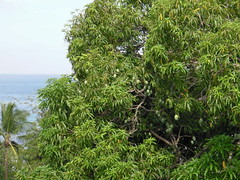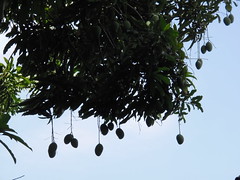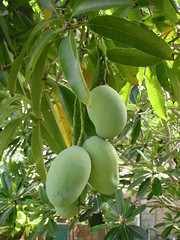
I am in Barbados on a Fulbright Scholarship. Originally it was a nine month appointment and it was recently extended to 11 months, I am happy to say. I’ll be here until mid-August. This post is to suggest some tips that worked for me in applying for the Fulbright. The announcement from the
CIES comes out in
April for the next academic year for the
U.S. Scholars Core Fulbright Scholar Program. Here is this
year’s listing for academic year 2011-2012. The online version is a great improvement over the paperback book. Though it’s fun to rifle through the book, it is easy to sort to what you’re interested in with the web version. This may save on paper, too. The deadline to apply is
August 2, 2010, so these tips should help get you on your way for your application.
Comb the
Fulbright web page to get a feel for the program. Take a look at the
Who’s Eligible page. Make sure you can apply for the Fulbright. You must be a U.S citizen, not a permanent resident.
Go through
this list in great detail. It is a huge list so sort to what your interests are. Set the search parameters in Search for Awards area. You can put in your discipline, whether you are looking for teaching and/or research (under Activity), country.
As I have said, you do not need a Ph.D. for many of the Fulbright grants so you can sort by No Ph. D. Required. For instance, I just searched on Teaching and Research, No Ph. D. required, Information Science, any geographic location and got 41 countries looking for me! See, that is what I did (with the paperback book) in April 2008 when I was looking for the placement I have now. I was overwhelmed by the places looking for some with technological skills and not requiring the Ph. D. Try it. Another example: Geology, requiring a Ph. D., all locations….there are too many to count.
Next weed out where you do not want to go. If you don’t feel like going to Ireland or the Maldives (picked at random, by the way), why waste your time looking at those countries?
When you have narrowed down your search to your discipline and the country, print out the page of information for each country. Yes, it’s a waste of paper, but jotting notes down on these sheets will help you sort out who you contacted, what department they’re in, dates and other useful information.
Now you need to make some contacts. Look at the university looking for a Fulbrighter. Look at the Grant Activities section. For example for Trinidad and Tobago at the Univ of the West Indies, St. Augustine campus, you will find this information on the Grant Activities:
Teach and conduct research in a wide range of disciplines including humanities, business administration, social sciences, or natural and applied sciences. Ratio of teaching to research is roughly 50/50. Do some research. Search the university’s web page thoroughly for your department or area of expertise. Contact the department chair. Contact a faculty member who shares your unique area of scholarship. Reach out by email. Make phone calls. Some areas in the world, especially the developing world, have limited and intermittent internet access so be persistent in your search to make contact. You will NEED a contact for your application, by the way, so be respectful and pleasant in all forms of communication. When I found a name and contact that looked promising, I wrote a fairly lengthy email and attached my CV. I wrote what my background was, what I could teach (“I see you teach Geographic Information System ENV707. I would love the opportunity to teach that course because I have taught GIS at XYZ College and I am…” Write about how your areas of scholarship and research might overlap with theirs. Be friendly and engaging. Remember that they do not need to pay you (though don’t write that in your email). You are a freeby to them. Your application will be stronger if you have a letter from someone in country. In fact, some countries require a letter of invitation. Mine did not.
Next, contact the Regional Program Officer (listed at the top of the Country Overview - Award page) to let them know you are interested in a particular country within their purview, an email or a phone call to let them know you exist. If you end up applying to the country that they oversee in the Fulbright program, the first time they hear of you should NOT be when your application rolls across their desk.
Take a look at the
past grant recipients list. Contact some of the Fulbrighters that had awards within the past three to five years to the country you wish to apply to. Ask all those questions you want to know about:
Did you feel supported by the department you were with? I want to take my children, how will that be for me? Was it safe there? What’s Malta like? How are the resources on campus? What’s the Library like? This was very helpful to me. Past Fulbrighters want to share their experiences (this blog is proof of that!) and some were quite honest with me. If you do win an award, the contact that you made will be someone to get back in touch with for those where should I live questions.
Your letters of recommendation should be from people who know you well, who will say good (but true) things about you, and can cover all the areas you want to highlight about yourself. If you are doing a teaching and research proposal, make sure one of your recommenders covers one aspect of those areas. I think it’s important to NOT have all your references come from the same institution, shows you get out and about.
I should probably have some words of advice about your five page proposal. Write it well. Be succinct. Once you’ve made an in-country contact, you will have a better idea of what 1) will be your research agenda, and 2) what you will teach. Talk about your research in a way that shows you have done this before and will be great at it. Talk about your teaching as though you know exactly what you are doing. Be positive. Use the active voice. Have people read it to see what they think. Intelligent non-specialists will be reading your application, so make it as clear as possible and totally free of disciplinary jargon. Have your in-country contact read it to see if it makes sense. It’s only five pages. Make them count.
That is what I have for today. These are things that you must be doing now if you want to be a Fulbright Scholar in 2011-2012. After your application is submitted (August 2, 2010 deadline!), you will wait and wait to hear anything. You may want to contact the Regional Program Officer to see how things are going. Your application will go through a U.S review first. If you make it through that, then your application goes (along with all the others that made it through the U.S. review) to the host country. If there are only two Fulbright Scholarship appointments for a country and there are ten qualifying applicants, well, you get the picture.
The Fulbright experience is an amazing opportunity. It is worth trying for. Good luck!



 Photos from my Flickr photostream.
Photos from my Flickr photostream.


 Photos from my Flickr photostream.
Photos from my Flickr photostream.
 Before I even moved to Barbados I heard that the ICC World Twenty20 Cricket matches would be held here and in other parts of the West Indies. I was excited because I have wanted to know more about cricket. I tried to learn about it when I was Trinidad, but never really got the hang of it. I'm starting to get it.
Before I even moved to Barbados I heard that the ICC World Twenty20 Cricket matches would be held here and in other parts of the West Indies. I was excited because I have wanted to know more about cricket. I tried to learn about it when I was Trinidad, but never really got the hang of it. I'm starting to get it. The "pitchers" are called bowlers. There are two bowlers out there, also taking turns at the batsmen. There's fast bowlers and slow bowlers and spinners. I think that the bowlers are trying to knock the wickets over (they are wooden stumps), so the batsmen are trying to defend the wicket yet still try to hit the ball for some runs. If there is a hit, the ball can be caught in the air for an out, or the ball can be thrown at the wicket, so the fielding player tries to get it there and hit it before the runner gets there.
The "pitchers" are called bowlers. There are two bowlers out there, also taking turns at the batsmen. There's fast bowlers and slow bowlers and spinners. I think that the bowlers are trying to knock the wickets over (they are wooden stumps), so the batsmen are trying to defend the wicket yet still try to hit the ball for some runs. If there is a hit, the ball can be caught in the air for an out, or the ball can be thrown at the wicket, so the fielding player tries to get it there and hit it before the runner gets there.